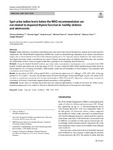2020-05-11Zeitschriftenartikel
Spot urine iodine levels below the WHO recommendation are not related to impaired thyroid function in healthy children and adolescents
Wallborn, Tillmann
Vogel, Mandy
Kneuer, Antje
Thamm, Michael
Dittrich, Katalin
Kiess, Wieland
Kratzsch, Jürgen
Purpose
Iodine deficiency in childhood and adolescence may lead to later thyroid dysfunction, stunted growth and cognitive impairment. The World Health Organization (WHO) has issued recommended age-dependent urine iodine concentration targets, but a critical threshold beyond which clinical sequelae are to be expected remains undefined. Our study aimed to investigate spot urine iodine concentration in a typical Central European cohort of children and adolescents, and consider the implications of these values in regard to laboratory parameters for evaluating thyroid function.
Methods
Using the Sandell-Kolthoff method, spot urine iodine concentration was measured cross-sectionally from 1802 healthy children and adolescent in the age range of 0.25–18 years within the LIFE-Child epidemiological study based in and around the city of Leipzig (Germany). Additionally, serum thyroid biomarkers of these subjects were measured and correlated to urine iodine levels.
Results
In our cohort, 61.39% of boys and 65.91% of girls had an iodine level of < 100 µg/L (57%, 67%, 65% of the age groups 0–5, 6–12 and 13–18 years), the median iodine excretion was 86 µg/L in boys and 80 µg/L in girls. The iodine levels revealed no significant correlation with the thyroid biomarkers TSH, FT4 and FT3. Moreover, iodine values revealed no correlation with levels of antibodies against thyroid peroxidase or thyroglobulin.
Conclusion
In our cohort of children and adolescents, the relatively high number of iodine levels below the WHO recommendation appears not to be related to clinical or subclinical thyroid diseases in the respective participants.

